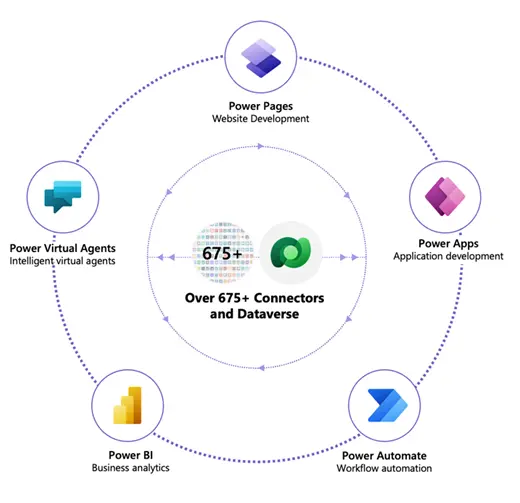
What is Microsoft Power Platform?
Power BI, Power Apps, Power Automate, Power Pages, and Power Virtual Agents are all part of the Microsoft Power Platform.
Microsoft Power BI provides business analytics. In addition to providing real-time insights from dynamic and non-dynamic data, you can create the most personalized reports on desktops and mobile devices.
Microsoft Power Apps is a no-code / low-code environment for building mobile-friendly business apps. As part of Microsoft's business applications, such as MS Teams, these apps connect to hundreds of third-party systems.
Automate workflows with this toolset. Business processes can be automated through templates, triggers, alerts, and RPA (Robotic Process Automation). With Power Automate, all this can be done quickly and without coding.
Microsoft Power Pages is a secure, enterprise-grade, low-code software as a service (SaaS) platform for creating, hosting, and administering modern external-facing business websites.
Power Virtual Agents lets you create powerful AI-powered intelligent bots using a guided, no-code graphical interface. AI-powered capabilities help you automate common questions and provide personalized customer services.
Why should we use Microsoft Power Platform?
1. A single platform for all enterprise processes
In the digital age, it is crucial to maintain a single source of truth for your business. It must be governed to be maintained – which means:
- Make sure the leadership is aligned from the start.
- Manage data ownership and stewardship with accountability.
- Be vigilant with shadow analysts.
- To evolve, apply a change management model.
What do you do beyond running a report when you have a data warehouse or tabular data model that holds such vast potential for your entire organization? A data-driven enterprise knows it needs to analyze, automate, act, and iterate cyclically. This difficult problem is easily solved with Microsoft Power Platform, which provides enterprises with an enterprise-grade platform that empowers any organization, even those that typically use multiple disparate tools.
2. Self-Service for Easy Adoption and Use
Many enterprise business applications require the assistance of your IT department or IT-savvy people in your department to be utilized effectively. Before now, non-IT professionals in finance, marketing, sales, etc., were constrained by the technical learning curve of business applications. They couldn’t use something like Azure on their own.
The Microsoft Power Platform’s no-code/low-code approach makes it easy to generate valuable insights from data, deploy rich applications, automate workflows, and leverage artificial intelligence. You can achieve these capabilities by simply dragging and dropping. It allows your citizen developers to quickly create and deploy applications, while your end users can take advantage of all features without any (or minimal) involvement from your IT department.

3. It's Just Microsoft
PowerApps, Power Automate, Power BI, and Power Virtual Agents are a powerful combination of Analyze, Act, Automate, and Iterate. Under the Microsoft ecosystem, you can enable end-to-end capabilities that work seamlessly together, simplifying everyday business processes.
If your organization uses Microsoft, you probably already have Power Platform licenses. Why don’t you use it instead of buying and integrating a third-party product?
4. Improves productivity and streamlines processes
Using Power Automate, you can automate repetitive tasks and processes that are done manually, saving you time for more valuable tasks. There are a few common routine tasks that can be automated with Power Automate:
- Approval of documents and processes
- Document generation
- Scheduled flows
It’s time to change your practices if your organization does everything manually. You should be concerned if your CFO still performs manual tasks in Excel each week. You can save time by using Power Automate instead of doing a lot of busywork.
5. Collaboration and remote work are made easier
You can seamlessly collaborate with teammates remotely and integrate web and mobile applications with cloud-based systems.
As remote workforces become more prevalent, being able to sync calendars and display tasks functionally is important to keeping employees up to date wherever they work. You can reduce your organization’s resource costs by constructing workflows that save employees’ time.
Document Automation System
We reduce your company's financial losses by organizing and automating all your documents with artificial intelligence by the Microsoft Power Platform.
Conclusion
If you already stay within the Microsoft ecosystem, the Microsoft Power Platform will be a great fit for you. Also, others can use free applications such as Power BI & Automate and upgrade them as required. However, the most effective results should come from integration. As a result, this platform should solve the most basic business problems, streamline tasks, and increase the workforce's efficiency. With Microsoft Power Platform, your data is democratized and unified. You can analyze data and act on new insights, customize business processes, and automate business processes using it, whether you are a tech user or a non-tech user at your organization.
DIDITRA Co-Founder & CEO
I was born in 1991 in Tehran, Iran. As a strategy and transformation activist who strives to make sustainable development the basis of the future world, my study and executive activities began in 2009 with a focus on two fields: social and economic development.
The spread of digital technology has led me to focus on developing industries and economic and social infrastructure using a digital transformation approach.


